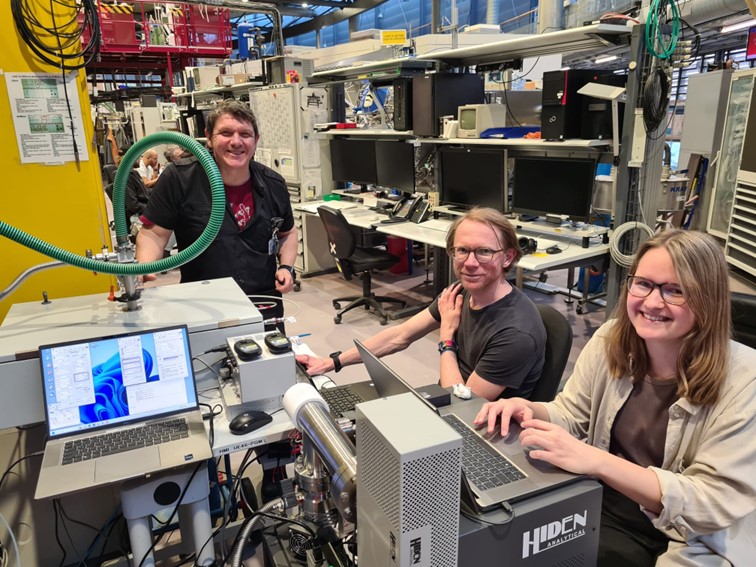
From left to right: Dirk Wallacher (HZB), Nico Grimm (HZB), and Gina Ruland (HZB).
Helmholtz-Zentrum Berlin (HZB) scientists* Catalina Elena Jimenez (scientific lead), Dirk Wallacher, Gina Ruland, Nico Grimm, Simone Vadilonga, Ivo Zizak, and Will Smith got together with scientists from University of Cape Town Shabaaz Abdullah, and Mohamed Fadlalla at HZB’s brilliant X-ray lightsource BESSY II, for the investigation of different reduction paths to obtain cobalt-based low temperature Fischer-Tropsch (LTFT) catalysts.
The experiment examined metallic cobalt (Co) in its active phase in LTFT synthesis, which has two allotrops: cubic α-Co and hexagonal β-Co. The starting Co-based compound, either a cobalt spinal oxide (Co3O4) or a cobalt carbide (Co2C) yields different α/β Co ratios, which in turn influences the FT catalyst performance. The aim of the experiment was to obtain high quality in-situ diffraction data for quantitative analysis that allows to develop strategies to gain control over the α/β Co ratio, which was successfully achieved by using the X-Ray diffraction method. The distinctive crystal structures of the Co allotrops and Co compounds underwent transformations that were well-resolved by powder X-ray diffraction in a timeframe that resembles real applications, under the brilliant X-ray light generated by BESSY II.
“In this first ROCK-IT experiment we automated the catalyst synthesis, controlling the temperature of the sample and gases and X-ray diffraction data acquisition using a measurement program. This meant that users did not have to operate the experiment manually.” explained Will Smith, emphasizing that the experiment provided them a lot of information for developing the next steps of ROCK-IT. The team tested the coaction of different elements developed within the project, and various ideas in areas such as sample holder design and experiment control. They also expressed their excitement working together with a team consisting of outstanding scientists from different fields.
Experimental details were designed in collaboration with Sasol, a global leader in Fischer-Tropsch synthesis, for the results to be industrially relevant. This experiment is part of the German Fedaral Ministry of Education and Research (BMBF) funded CARE-O-SENE project (contract 03SF0673A), a wider effort to develop catalysts for sustainable jet fuel production to support the global energy transition.
* Scientists‘ names are written in alphabetical order.
